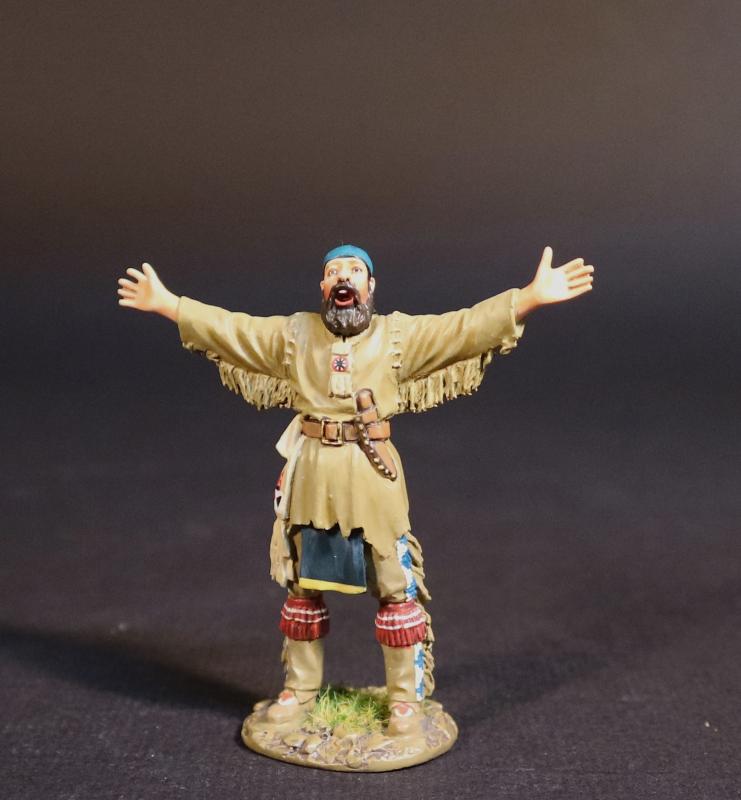The Singer, The Mountain Men, The Fur Trade--single figure
$54.00
Item Number: WSP-52A
The Singer, The Mountain Men, The Fur Trade
The image of the lone trapper taking his leave of “civilization” and daringly plunging into the wilderness to meet grizzly bears, harsh winters, mountain lions, and American Indians has sparked the imaginations of millions. Stripped of its romanticism, the fur trade was a hard business, and its labor force was as overworked, underpaid, and subject to hardships as any other nineteenth century occupation. Bent over by the strains of their livelihood, few trappers remained in the business past the age of forty.
Of those who decided to enter the fur trade business, many failed in their attempts to garner profits. However, those with enough experience, ability, and luck were often able to make a decent living. Acquiring furs and transporting them to eastern markets presented a logistical nightmare. Moving pack trains of supplies into the mountains, and returning with bales of furs, was an incredible task. The thousand-mile trek through inhospitable western plains, rugged mountain passes, and lands claimed by occasionally unfriendly American Indians often invited tragedy. Carefully packed for weight and balance, a trade bale weighed approximately 90 pounds (41kg).
Another important economic dynamic of the fur trade was the depletion of the beaver which resulted from over-harvesting. In 1793 alone, more than 182,000 beaver pelts were shipped via the Grand Portage—a volume that was unsustainable and detrimental to the North American beaver population.
It has long been a tradition to view the environment as if resources were unlimited, and many business-minded merchants and trappers were determined to extract any resource that was easily exploitable. This attitude of short-term exploitation flourished during the fur trade and persisted after 1840, as the focus shifted from furs to minerals, timber, grass, land, and water. Over trapping led to the virtual extermination of the beavers; their exhaustion and the simultaneous decline in the popularity of beaver fur hats, replaced by fashionable silk ones, brought an end to an era.
As they gathered furs, the trappers worked hand-in-hand, and sometimes competed, with American Indian tribes who had their own cultural traditions and distinct points of view. On the western plains and Rocky Mountains, the two very different cultures exchanged trade goods, but also ideas. As they came together in this wilderness, each culture would have to adapt to the other’s presence.
These two very different cultural legacies collided on the western frontier. Yet each accepted innovations from the other which suited their needs. The traders adopted American Indian foods, clothing, language, and geographic knowledge. Trappers and traders frequently took native wives, both to secure a helpmate and to solidify trading relations with specific tribes. The American Indians, in turn, welcomed manufactured trade goods such as iron awls and pots, beads, guns, and knives. Plains Indians expanded their production of bison robes to meet the new demands. In the long run, the exchange of robes for manufactured goods created a one-sided trade relationship. Many American Indians became dependent upon European-American trade goods, while others fought with each other for control of the hunting grounds. The effects of disease introduced by the European Americans seriously strained their social and cultural traditions. The strains created by the fur trade sometimes led to brief but violent conflict. Yet the traders and American Indians who exchanged goods and ideas had to meet on peaceful terms in order for the process to take place.
The fur trade and the knowledge exchanged between these two cultures would also lead to further settlement of the West. By the end of the fur trade era, the American population was ready to move west in search of new opportunities. Due to the fur trade, the migrating pioneers ventured into a landscape that was well charted, and one about which a great deal was known. Military explorers and settlers alike hired retired trappers and traders to guide them to their Western destinations. One of the major achievements of the fur trade was the conversion of the trapper’s geographic knowledge, much of which was learned from various American Indian tribes, onto maps. In this sense, the trappers and traders of the 1820s and 1830s represented the vanguard of the great western migrations of the 1840s and beyond.
Released in NOVEMBER 2024.
